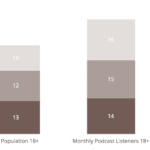Why Isn’t Anyone Marketing Podcasts Correctly?

Nobody is doing podcast marketing right. And by that I mean, everyone is doing what they think is right — using the traditional methods — instead of thinking outside the box. Here’s an anecdote that may only resonate with a small percent of you, however, the conclusion will make sense. Bear with me.
In the late 1990s and early aughts, Yahoo! was an early adopter at a growing trend, fantasy sports. ESPN, self-proclaimed worldwide leader in sports, realized a little too late this wasn’t a fad that would burn off, but instead would become a major influence for a lot of sports fans. By the time ESPN entered the fantasy scene Yahoo! had a commanding lead in the market share. ESPN fantasy sports pundit, Matthew Berry, recounts this in his book “Fantasy Life.” Their initial marketing efforts were driven by one goal: getting people to switch from Yahoo! to ESPN for their fantasy sports. It’s the logical initial move, but it wasn’t working. Existing players didn’t want to migrate over to ESPN, they already had their leagues and (more importantly) their habits set on Yahoo! ESPN then shifted their marketing. Instead of focus on existing fantasy players, they targeted casual sports fans who hadn’t yet played fantasy sports.
Do you see where I’m going here?
The Current Growth of Podcasts
In the latest Infinite Dial Report, the podcast audience continued its steady growth. Each year the growth and familiarity metrics grow by a couple percentage points. But does it have to be steady? This isn’t just an industry problem that individual podcasters should accept or become complacent about either. I was talking with a prominent podcast studio marketing lead at SXSW and discovered their top show (a show that’s likely in everyone’s short list for favorites) is growing at a steady pace that mirrors the landscape as a whole. Podcasts, for as good as they are, will reach a plateau unless the industry grows.
Even a monumental event like Serial, which many people say put podcasts on the mainstream map, didn’t have a substantial sustainable impact — much to everyone’s chagrin. I displayed a similar chart into my true crime analysis, but here is the search volume comparing “Serial Podcast” and “Podcast”.
How Podcast Marketing Should Go
The popularity lift is easy to see … but so is the consequential drop-off. The run rate (the base prior to the Serial bump) only minimally raises after Serial burns off. A more promising chart would look something like this where the the Serial popularity isn’t just a fad, but a stepping stone that raises all podcast popularity.

Instead of podcasts marketing to existing podcast fans, they should be marketing to people who aren’t yet fans at all. If I had any artistic chops, I’d draw a comic strip of all these mice fighting over a wheel of cheese while a much larger wheel sits untouched next to it. In the aforementioned Infinite Dial Report, only 44% of the population have ever listened to a podcast. This means at least 56% of the population likely isn’t being marketed to.
Sure, there will be people who don’t get podcasts and likely never will. But think back to your first podcast. Chances are someone recommended you listen to a specific show or episode and you were hooked from then on out. This is the same word-of-mouth motion that needs to be happening on a larger scale.
The only network I’ve seen do this, and it’s for financial purposes rather than altruistic, is Gimlet. By launching their TV and film division, they’re forcing podcasts (their podcasts) into the mainstream conversation. We don’t know exactly what returns this will show, but it’s the right idea.

We’re all guilty of talking with other podcast fans about the latest and greatest podcasts, but what if instead we talked to non-podcast fans? How many of you have heard friends and acquaintances say something like “yeah, I haven’t gotten into podcasts” or “I’m not sure if podcasts are for me”? These people — or those who only briefly dabbled in podcasts — are prime to be converted to regular listeners just like you.
At the risk of sound too cliche …. a rising tide lifts all boats.













1 comment
Two thoughts on this:
– Practically, there’s a lack of knowledge around podcasts (what are these? Who has the time to listen to them? How do I listen to them?) and a strong direct competition for people’s time (music streaming services). The people who listen to podcasts do so instead of listening to music.
– Many podcasts aren’t effectively leveraging other marketing channels. There’s a reason podcasts like Amy Porterfield’s Online Marketing Made Easy and Tim Ferriss’s show have become such hits—they advertise on other platforms and they own the connection with their audience via email. They also both produce stellar, professional, and highly useful content.
Comments are closed.